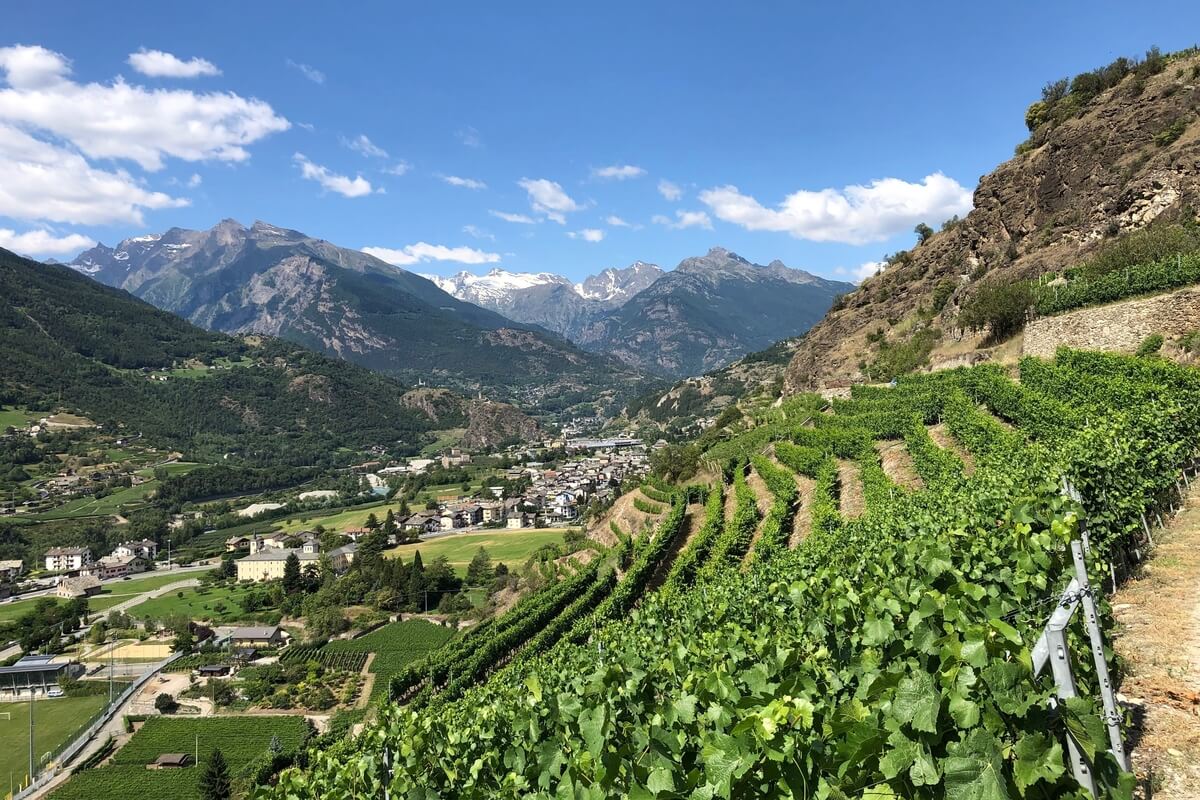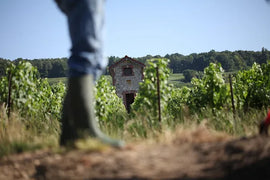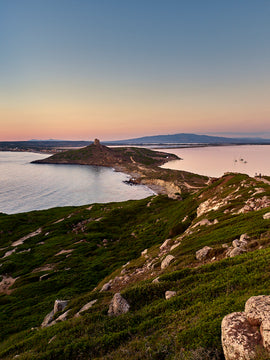VALLE D’AOSTA
Nestled in the northwestern corner of Italy lies a small but precious region. Located above Piemonte and surrounded by the magnificent Gratian Alps in the north, it shares borders with France and Switzerland. Standing tall at 4,810 meters (15,781ft), Monte Bianco, or Mont Blanc, dominates the views from the valleys of this region, making it the highest peak in Europe and the 17th highest in the world. Valle d’Aosta is primarily known for its breathtaking natural beauty and impressive alpine range, attracting countless rock climbers, alpine skiers, and enthusiastic adventurers to explore the area. Throughout the valleys, charming castles can be found, with a total of 72 in the main valley alone. These castles, built between the 2nd and 16th centuries, are among the main attractions for tourists. Surprisingly, the region also offers delightful and distinct wines. It may be hard to believe that vines can grow here, but as we will discover, Valle d’Aosta produces truly fascinating and unique wines. So, lace up your hiking boots and let's embark on a journey to reach the pinnacle of the world of wine.
Valle d’Aosta, also known as Vallée d'Aoste, was once covered by a vast glacier. After the glacier receded, it left behind a broad valley carved by the river Dora Baltea, which stretches across the region for 100km (62mi). With a territory spanning 3,268 km2 (1,261 square miles) and a population of 126,000 inhabitants, Valle d’Aosta is one of the smaller and less populous regions of Italy. Aosta serves as both the capital and the only province within the region.
The imagination, strength, determination, and artistic expression associated with wine in this region is truly remarkable. It is unexpected that vineyards can thrive at such high altitudes of 4000 feet. The alpine geography, with its towering peaks and freezing temperatures for most of the year, would deter any rational winemaker. However, the Valdostani people have defied the odds by carefully constructing terraced slopes using rocks and bricks to control the challenging terrain shaped by glacial alluvial soil of rock moraine and sand. The vines have played a crucial role, penetrating deep into the ground to extract nutrients and stabilize the soil to prevent downhill erosion. Cultivating the land in these conditions necessitates the abandonment of mechanization and industrial techniques, placing the entire burden on the farmers' physical labor. With inclinations reaching up to 30%, one must possess the skills of both a farmer and a climber. This unique form of viticulture is often referred to as 'Extreme Viticulture' or 'Viticultura Eroica'.
Valle d'Aosta accounts for a mere 0.1% of Italy's total wine production, yielding approximately 1 million bottles from a cultivation area of 1290 acres. However, what sets these wines apart is their distinctiveness. We have previously discussed the numerous indigenous grape varieties found throughout Italy, but here we encounter even more exclusivity. These grapes can only be found in this particular region and are not grown elsewhere. Among the white grapes are Prie' Blanc, Malvoisie, and Petit Arvine, while the red grapes include Cornalin, Mayolet, Petit Rouge, Premetta, Vien de Nus, and Fumin. Additionally, there are other significant grape varieties such as Nebbiolo, known as Picotendro in this area, which originates from the nearby Piemonte region. Gamay, Pinot Noir, Syrah, and Chardonnay are also cultivated here.
Alla vostra salute!
Carrie Upson- GM and Wine Buyer
|
La Source Petite Arvine 2020 |
|
|
Region / Country of Origin: Aymavilles, Valle d’Aosta, Italy |
About the vineyard: La Source was founded in 2003 from the experience and passion of young farmers, descendants of Aosta Valley families dedicated to agriculture for generations. The company takes its name from the small spring that was found when they built the cellar; la source in French in fact means source. It is located in Saint Pierre village, 7 km from Aosta city, a few steps from the castle of the same name. Currently the company is owned by the Celi-Cuc family and Stefano Celi is its soul, descendant of a family that has been dedicated to agriculture in the Aosta Valley for generations. About the winemaking: Vinified with great care, the grapes are delicately crushed, followed by static cold decanting. The must ferments in stainless steel tanks at a controlled temperature of about 18°C to preserve the best characteristics of the wine. The wine is gently stirred on the fine lees for a few months before being filtered and prepared for bottling. Tasting Notes: Color: Straw yellow with green hues. Bouquet: Elegant, fruity and floral aromas. Flavor: Fresh but at the same time intense, persistent and elegant, revealing aromas of white fruit with a hint of exotic fruit, and a good minerality. |
|
Enologist: Mario Ronco |
|
|
Price: $23.99 btl/$259 cs |
|
|
Suggested Food Pairing: It goes well as an aperitif or with appetizers, light first courses and cheeses |
|
|
Grosjean Gamay Noir 2022 |
|
|
Region / Country of Origin: Ollignan, Valle d’Aosta, italy |
About the Winery: The Grosjean family traces its roots back to the village of Fornet in the high mountain passes of the Valle d’Aosta known as Valgrisenche where they raised cattle. During the summer months, the family cultivated grapes and chestnuts on the slopes at lower altitude, stocking up on wine to supply themselves over the long winters. In 1969, Dauphin Grosjean, the father of the five sons that now collaborate to produce the wines of this estate, was encouraged to present his wine at the local “wine expo”. The exceptional quality of his work was recognized and the entire family became engaged in the expansion of the vineyards and in the production of wine. About the winemaking: Fermentation: Natural yeasts are utilized for fermentation; 4-5 days maceration on the skins in stainless steel. Élevage: 8-10 months in stainless-steel. Lees: Wines remain on their fine lees until assemblage prior to bottling. Fining and Filtration: All wines are unfined and lightly filtered. Sulfur: Applied only when necessary in minimal amounts, and only at bottling. Tasting Notes: A Burgundian native, Grosjean’s Valdôtain Gamay comes from the valley’s steep, south-facing upper slopes in the villages of Quart, Saint Christophe and Villeneuve. Grosjean’s biodynamically farmed Gamay example is always well balanced, fruit-forward, lightly tannic and fresh with abundant aromatics of smokiness and strawberry. |
|
Enologist: Herve Grosjean |
|
|
Price: $25.99 btl/$280.69 cs |
|
|
Suggested Food Pairing: An excellent partner to traditional charcuterie, including salami, motzetta and thinly sliced lard, along with traditional Aosta soups |
|





